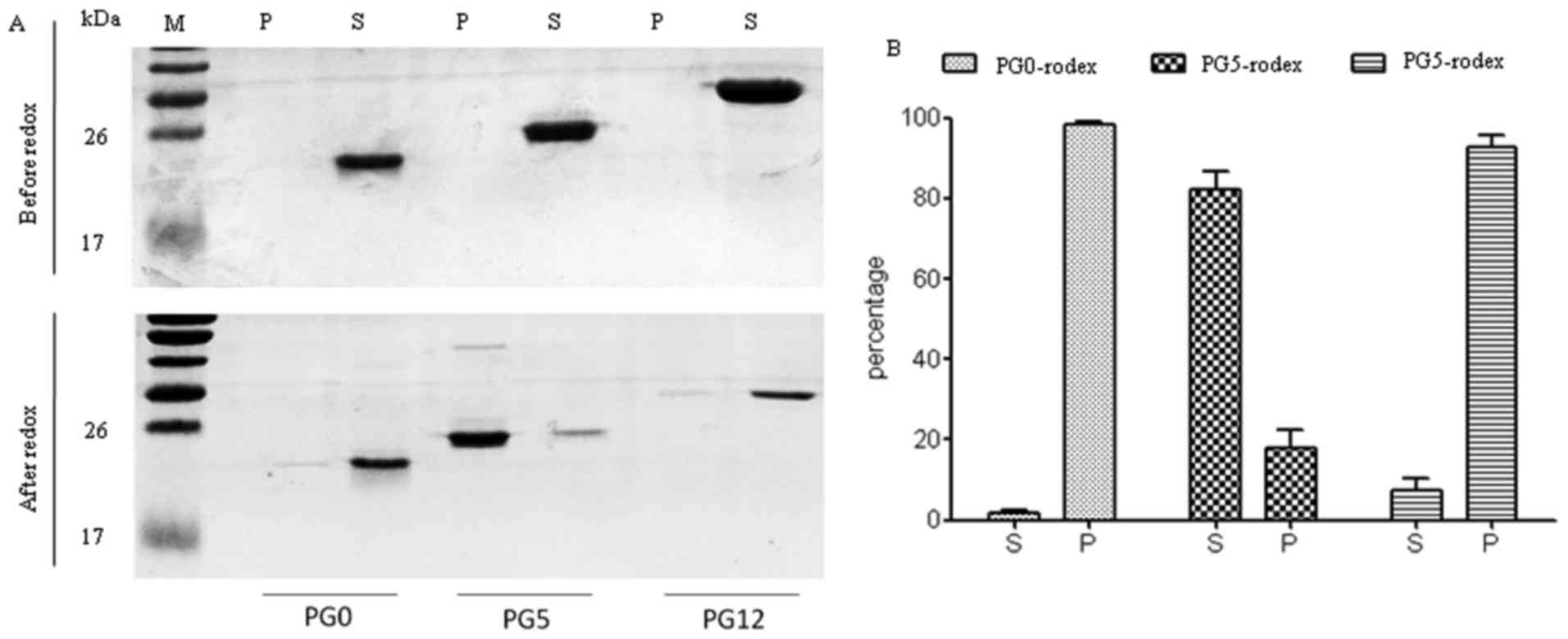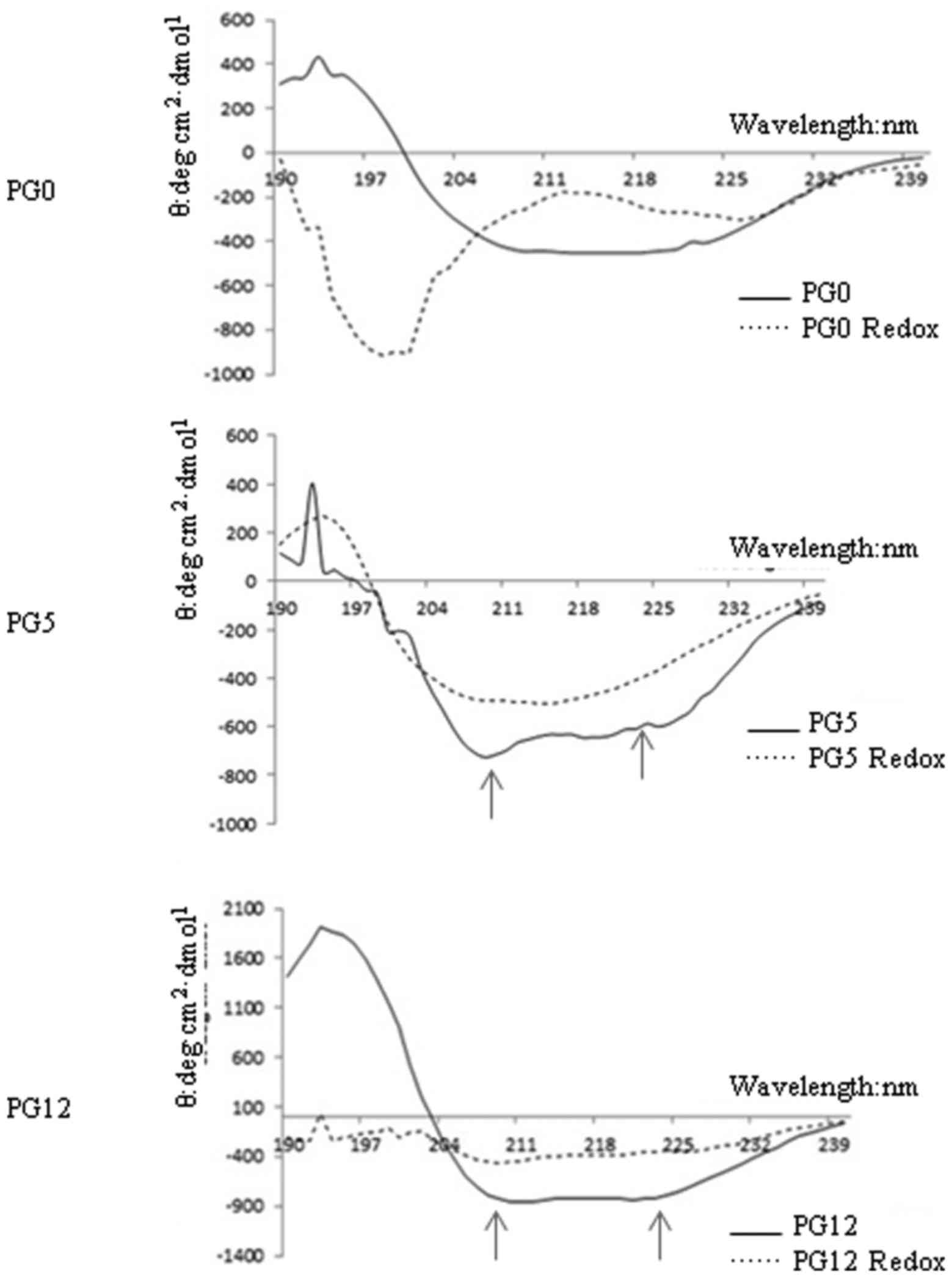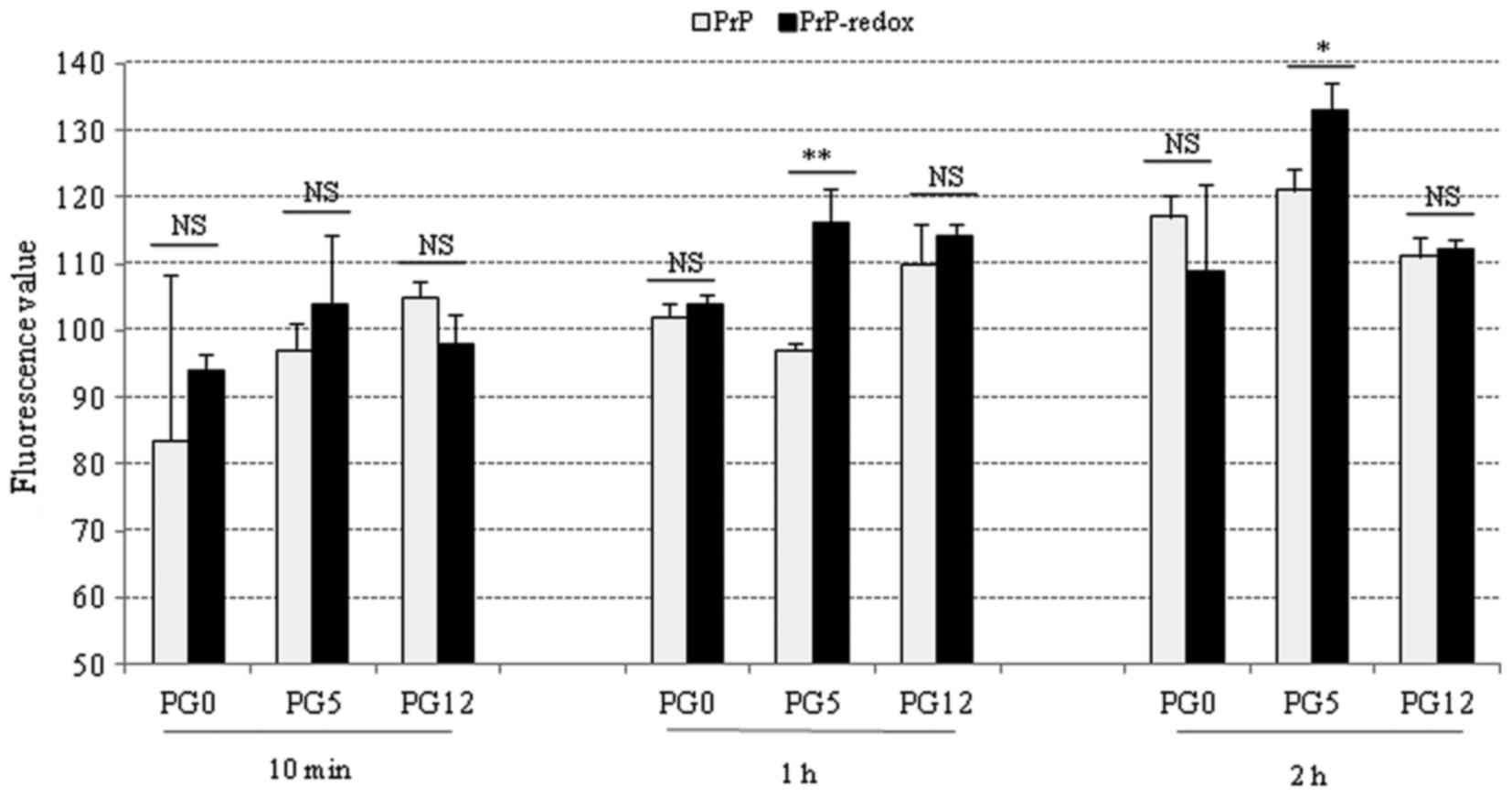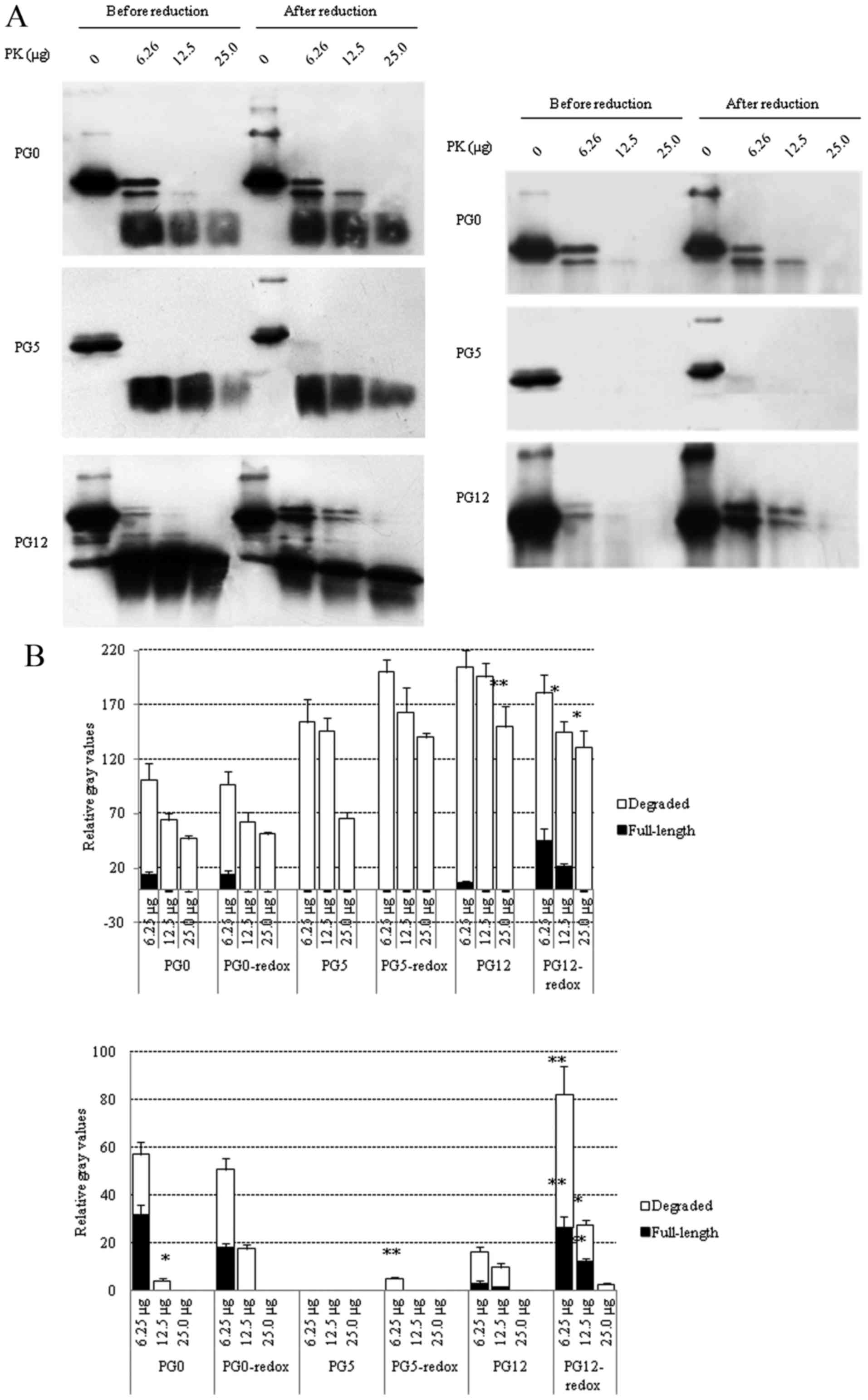|
1
|
Colby DW and Prusiner SB: Prions. Cold
Spring Harb Perspect Biol. 3:a0068332011. View Article : Google Scholar : PubMed/NCBI
|
|
2
|
Prusiner SB, Scott MR, DeArmond SJ and
Cohen FE: Prion protein biology. Cell. 93:337–348. 1998. View Article : Google Scholar : PubMed/NCBI
|
|
3
|
Stellato F, Minicozzi V, Millhauser GL,
Pascucci M, Proux O, Rossi GC, Spevacek A and Morante S:
Copper-zinc cross-modulation in prion protein binding. Eur Biophys
J. 43:631–642. 2014. View Article : Google Scholar : PubMed/NCBI
|
|
4
|
Paucar M, Xiang F, Moore R, Walker R,
Winnberg E and Svenningsson P: Genotype-phenotype analysis in
inherited prion disease with eight octapeptide repeat insertional
mutation. Prion. 7:501–510. 2013. View Article : Google Scholar : PubMed/NCBI
|
|
5
|
Beck JA, Mead S, Campbell TA, Dickinson A,
Wientjens DP, Croes EA, Van Duijn CM and Collinge J:
Two-octapeptide repeat deletion of prion protein associated with
rapidly progressive dementia. Neurology. 57:354–356. 2001.
View Article : Google Scholar : PubMed/NCBI
|
|
6
|
Wiseman FK, Cancellotti E, Piccardo P,
Iremonger K, Boyle A, Brown D, Ironside JW, Manson JC and Diack AB:
The glycosylation status of PrPC is a key factor in
determining transmissible spongiform encephalopathy transmission
between species. J Virol. 89:4738–4747. 2015. View Article : Google Scholar : PubMed/NCBI
|
|
7
|
Yang Y, Chen L, Pan HZ, Kou Y and Xu CM:
Glycosylation modification of human prion protein provokes
apoptosis in HeLa cells in vitro. BMB Rep. 42:331–337. 2009.
View Article : Google Scholar : PubMed/NCBI
|
|
8
|
Kuczius T and Kelsch R: Effects of metal
binding on solubility and resistance of physiological prions depend
on tissues and glycotypes. J Cell Biochem. 114:2690–2698. 2013.
View Article : Google Scholar : PubMed/NCBI
|
|
9
|
Ning L, Guo J, Jin N, Liu H and Yao X: The
role of Cys179-Cys214 disulfide bond in the stability and folding
of prion protein: Insights from molecular dynamics simulations. J
Mol Model. 20:21062014. View Article : Google Scholar : PubMed/NCBI
|
|
10
|
Maiti NR and Surewicz WK: The role of
disulfide bridge in the folding and stability of the recombinant
human prion protein. J Biol Chem. 276:2427–2431. 2001. View Article : Google Scholar
|
|
11
|
Singh N, Singh A, Das D and Mohan ML:
Redox control of prion and disease pathogenesis. Antioxid Redox
Signal. 12:1271–1294. 2010. View Article : Google Scholar :
|
|
12
|
An R, Dong C, Lei Y, Han L, Li P, Chen J,
Wang G, Shi Q, Gao C, Jiang H, et al: PrP mutants with different
numbers of octarepeat sequences are more susceptible to the
oxidative stress. Sci China C Life Sci. 51:630–639. 2008.
View Article : Google Scholar : PubMed/NCBI
|
|
13
|
Zhang FP, Zhang J, Zhou W, Zhang BY, Hung
T and Dong XP: Expression of PrP(C) as HIS-fusion form in a
baculovirus system and conversion of expressed PrP-sen to PrP-res
in a cell-free system. Virus Res. 87:145–153. 2002. View Article : Google Scholar : PubMed/NCBI
|
|
14
|
Lee S and Eisenberg D: Seeded conversion
of recombinant prion protein to a disulfide-bonded oligomer by a
reduction-oxidation process. Nat Struct Biol. 10:725–730. 2003.
View Article : Google Scholar : PubMed/NCBI
|
|
15
|
Dietz KJ and Hell R: Thiol switches in
redox regulation of chloroplasts: Balancing redox state, metabolism
and oxidative stress. Biol Chem. 396:483–494. 2015. View Article : Google Scholar : PubMed/NCBI
|
|
16
|
Ckless K: Redox proteomics: From bench to
bedside. Adv Exp Med Biol. 806:301–317. 2014. View Article : Google Scholar : PubMed/NCBI
|
|
17
|
Rana A, Gnaneswari D, Bansal S and Kundu
B: Prion metal interaction: Is prion pathogenesis a cause or a
consequence of metal imbalance? Chem Biol Interact. 181:282–291.
2009. View Article : Google Scholar : PubMed/NCBI
|
|
18
|
Zhu F, Davies P, Thompsett AR, Kelly SM,
Tranter GE, Hecht L, Isaacs NW, Brown DR and Barron LD: Raman
optical activity and circular dichroism reveal dramatic differences
in the influence of divalent copper and manganese ions on prion
protein folding. Biochemistry. 47:2510–2517. 2008. View Article : Google Scholar : PubMed/NCBI
|
|
19
|
Kim NH, Choi JK, Jeong BH, Kim JI, Kwon
MS, Carp RI and Kim YS: Effect of transition metals (Mn, Cu, Fe)
and deoxycholic acid (DA) on the conversion of PrPC to
PrPres. FASEB J. 19:783–785. 2005. View Article : Google Scholar : PubMed/NCBI
|
|
20
|
Cingaram PK, Nyeste A, Dondapati DT, Fodor
E and Welker E: Prion protein does not confer resistance to
hippocampus-derived zpl cells against the toxic effects of
Cu2+, Mn2+, Zn2+ and
Co2+ not supporting a general protective role for PrP in
transition metal induced toxicity. PLoS One. 10:e01392192015.
View Article : Google Scholar
|
|
21
|
Riesner D, Kellings K, Post K, Wille H,
Serban H, Groth D, Baldwin MA and Prusiner SB: Disruption of prion
rods generates 10-nm spherical particles having high alpha-helical
content and lacking scrapie infectivity. J Virol. 70:1714–1722.
1996.PubMed/NCBI
|
|
22
|
Lu BY and Chang JY: Rapid and irreversible
reduction of protein disulfide bonds. Anal Biochem. 405:67–72.
2010. View Article : Google Scholar : PubMed/NCBI
|
|
23
|
Yuan Z, Yang L, Chen B, Zhu T, Hassan MF,
Yin X, Zhou X and Zhao D: Protein misfolding cyclic amplification
induces the conversion of recombinant prion protein to PrP
oligomers causing neuronal apoptosis. J Neurochem. 133:722–729.
2015. View Article : Google Scholar : PubMed/NCBI
|
|
24
|
Shin JY, Shin JI, Kim JS, Yang YS, Shin
YK, Kim KK, Lee S and Kweon DH: Disulfide bond as a structural
determinant of prion protein membrane insertion. Mol Cells.
27:673–680. 2009. View Article : Google Scholar : PubMed/NCBI
|
|
25
|
Zhou X, Bi H, Wong J, Shimoji M, Wang Y,
Yuan J, Xiao X, Wang GX and Zou WQ: Alkylating antitumor drug
mechlorethamine conceals a structured PrP domain and inhibits in
vitro prion amplification. J Toxicol Environ Health A.
74:1493–1503. 2011. View Article : Google Scholar : PubMed/NCBI
|
|
26
|
Dong CF, Wang XF, An R, Chen JM, Shan B,
Han L, Lei YJ, Han J and Dong XP: Interaction analysis between
various PrP fusion proteins and the tubulin in vitro. Bing Du Xue
Bao. 23:28–32. 2007.(In Chinese).PubMed/NCBI
|
|
27
|
Dong CF, Shi S, Wang XF, An R, Li P, Chen
JM, Wang X, Wang GR, Shan B, Zhang BY, et al: The N-terminus of PrP
is responsible for interacting with tubulin and fCJD related PrP
mutants possess stronger inhibitive effect on microtubule assembly
in vitro. Arch Biochem Biophys. 470:83–92. 2008. View Article : Google Scholar
|
|
28
|
Mitteregger G, Vosko M, Krebs B, Xiang W,
Kohlmannsperger V, Nölting S, Hamann GF and Kretzschmar HA: The
role of the octarepeat region in neuroprotective function of the
cellular prion protein. Brain Pathol. 17:174–183. 2007. View Article : Google Scholar : PubMed/NCBI
|
|
29
|
Li XL, Dong CF, Wang GR, Zhou RM, Shi Q,
Tian C, Gao C, Mei GY, Chen C, Xu K, et al: Manganese-induced
changes of the biochemical characteristics of the recombinant
wild-type and mutant PrPs. Med Microbiol Immunol (Berl).
198:239–245. 2009. View Article : Google Scholar
|













